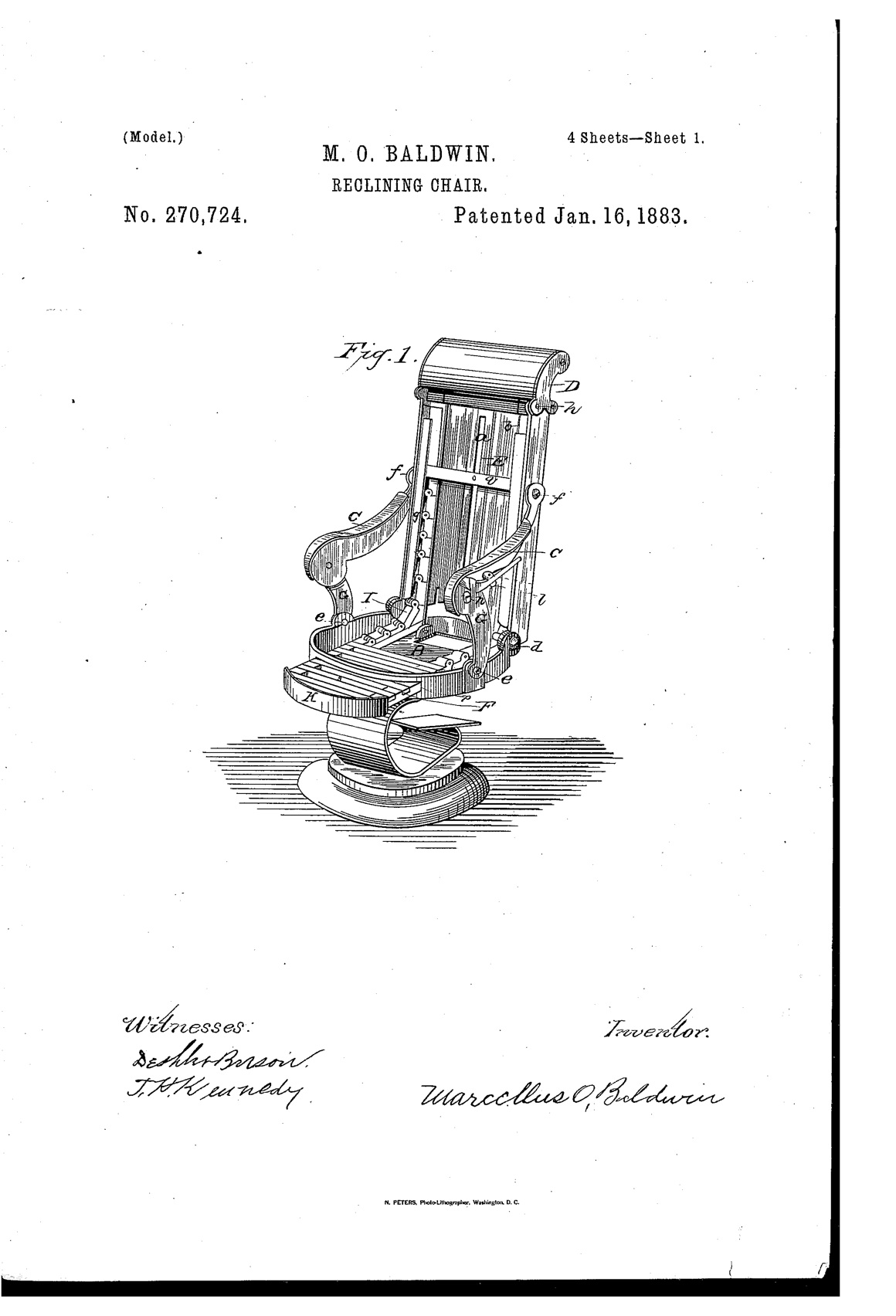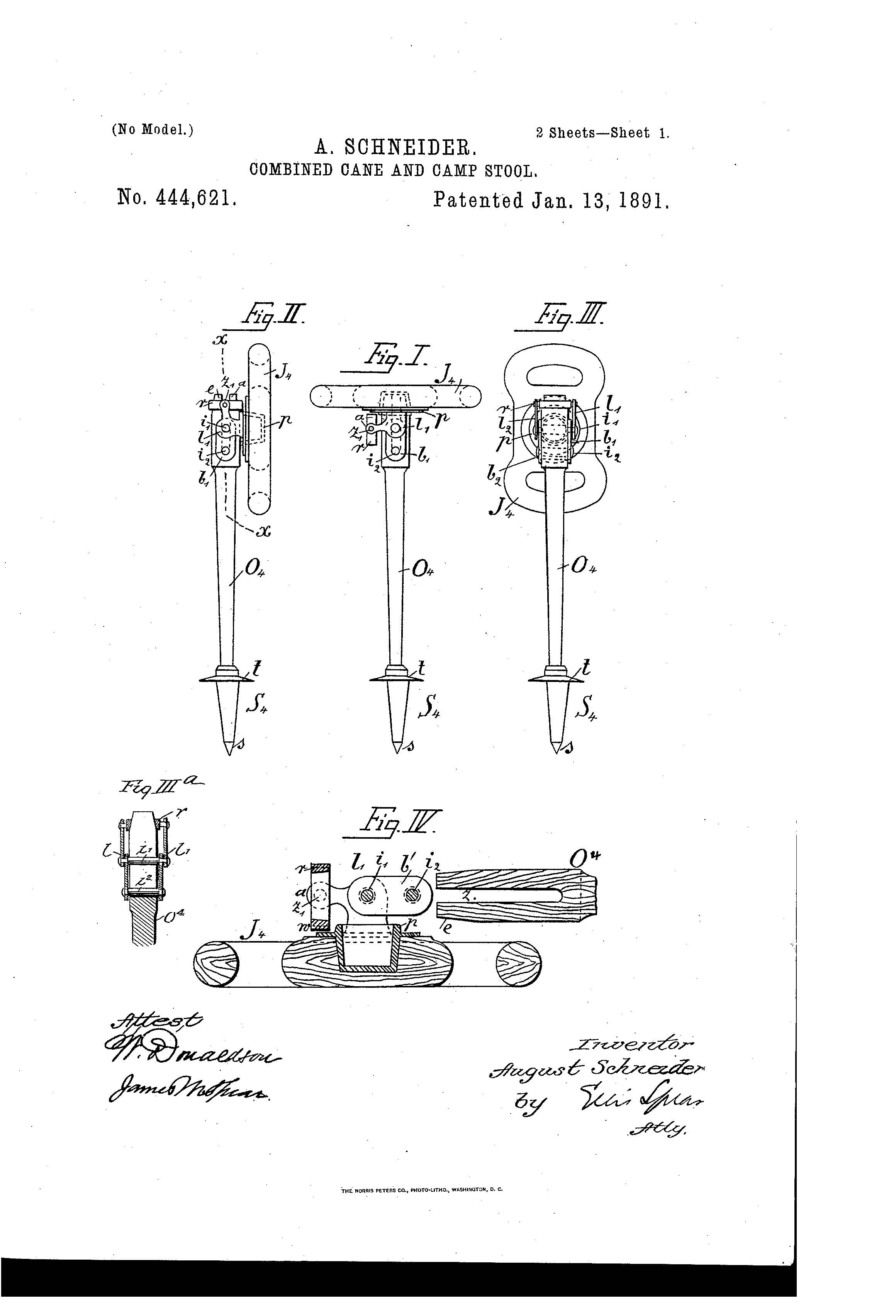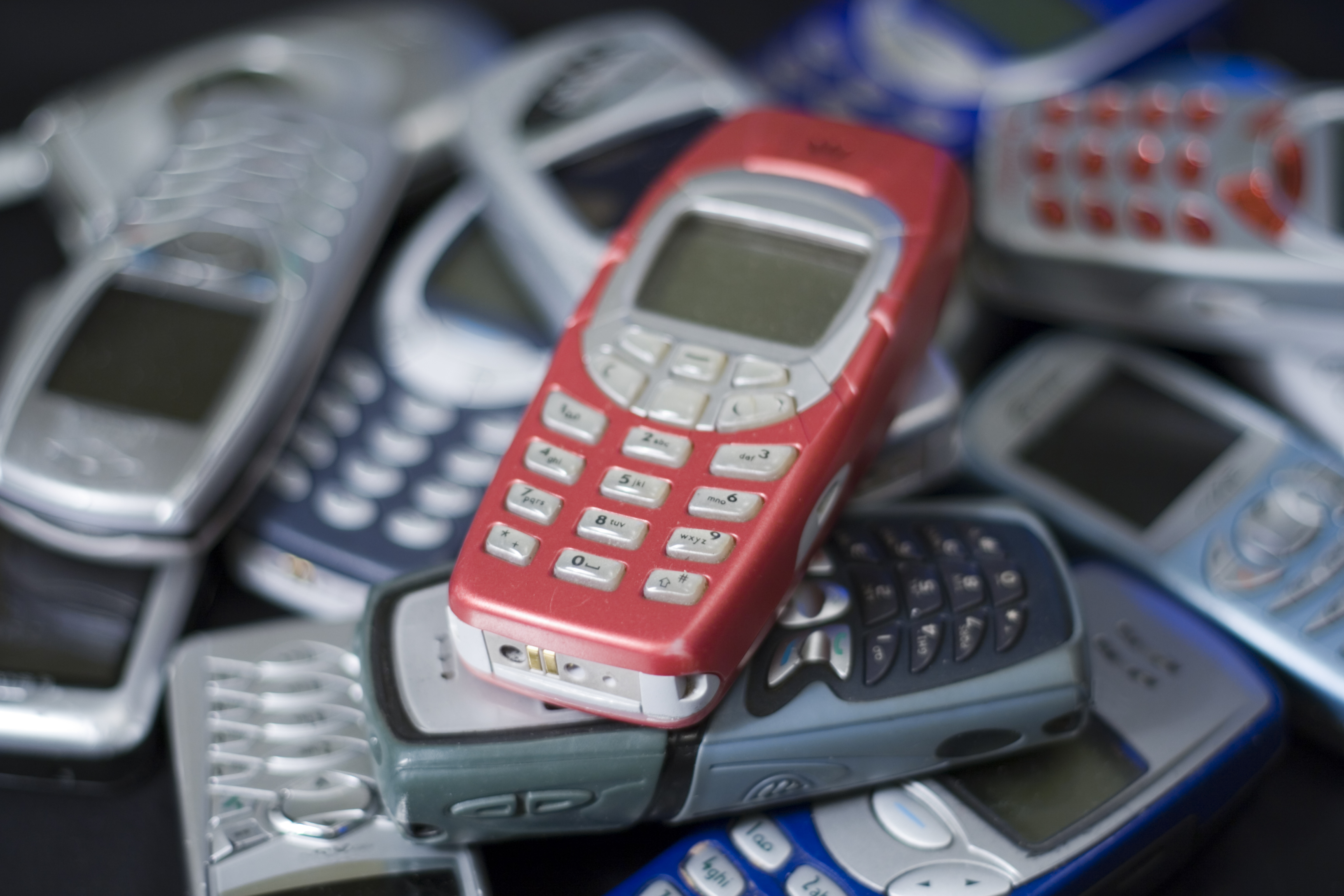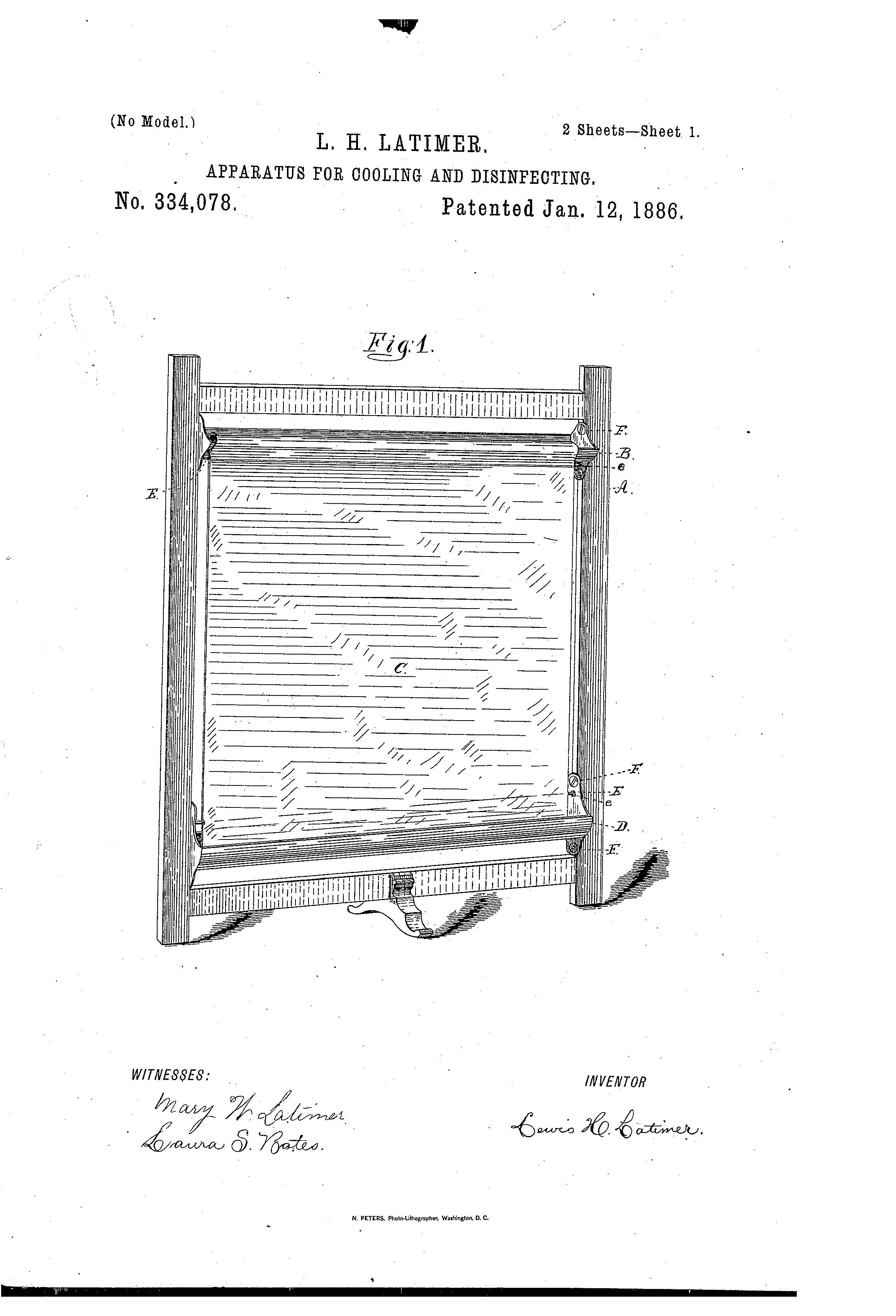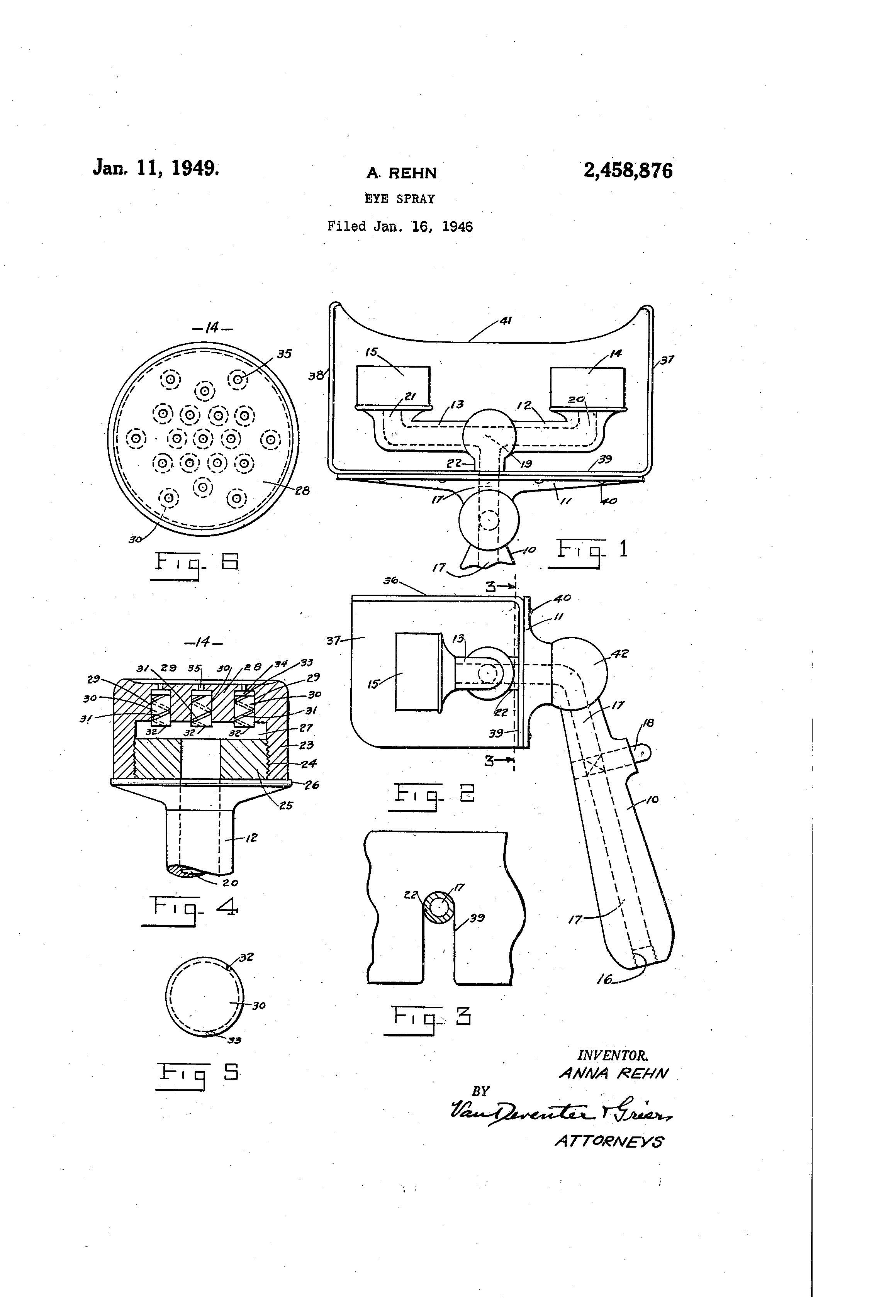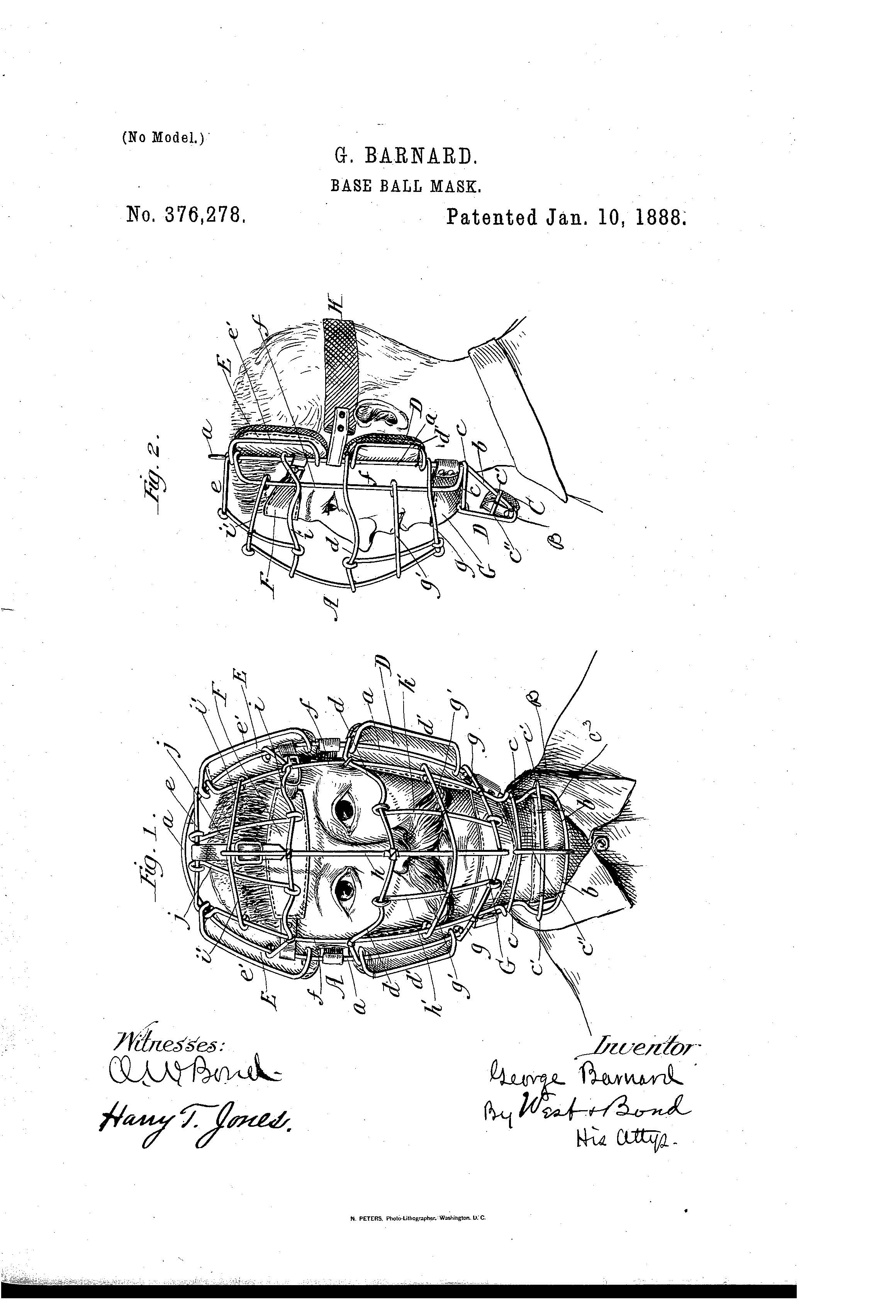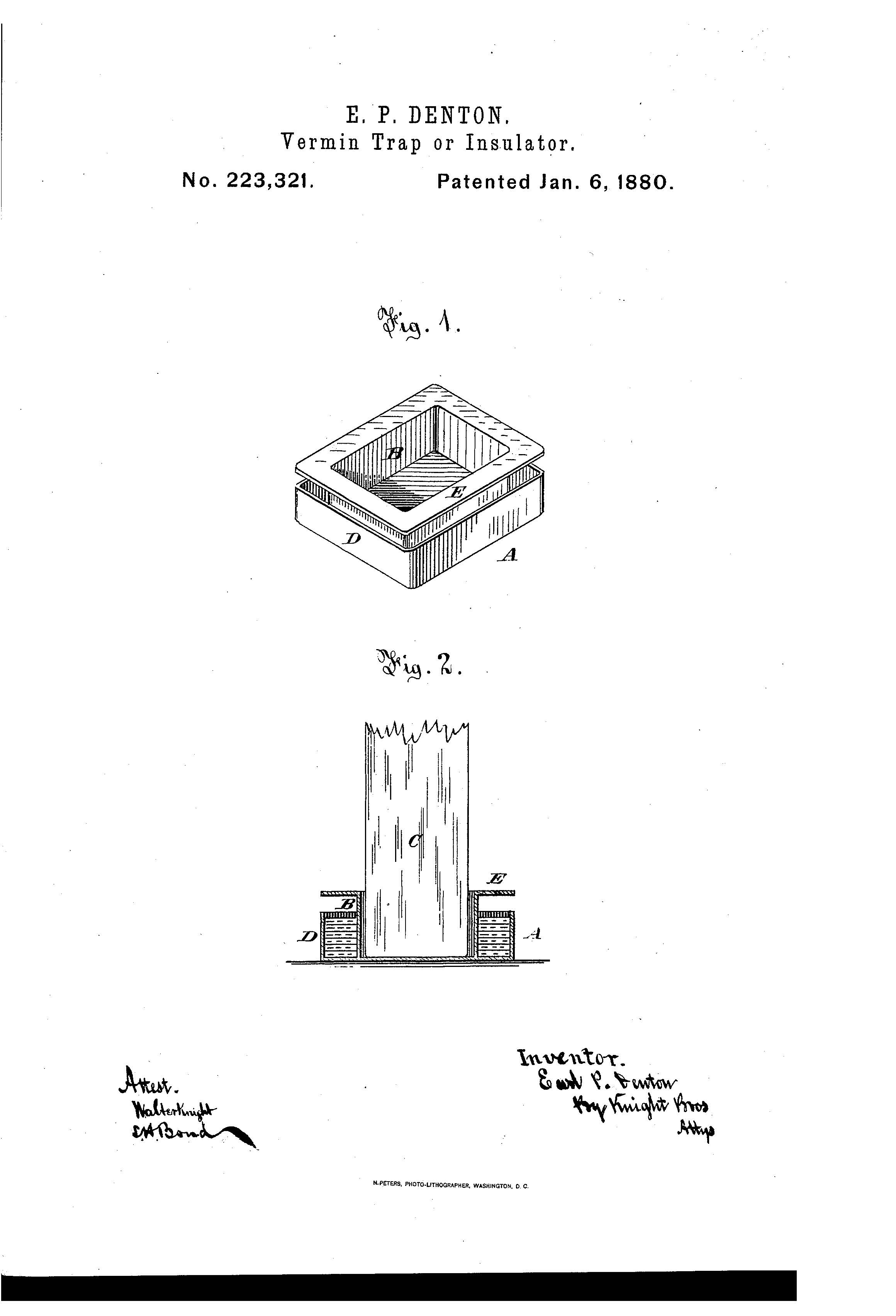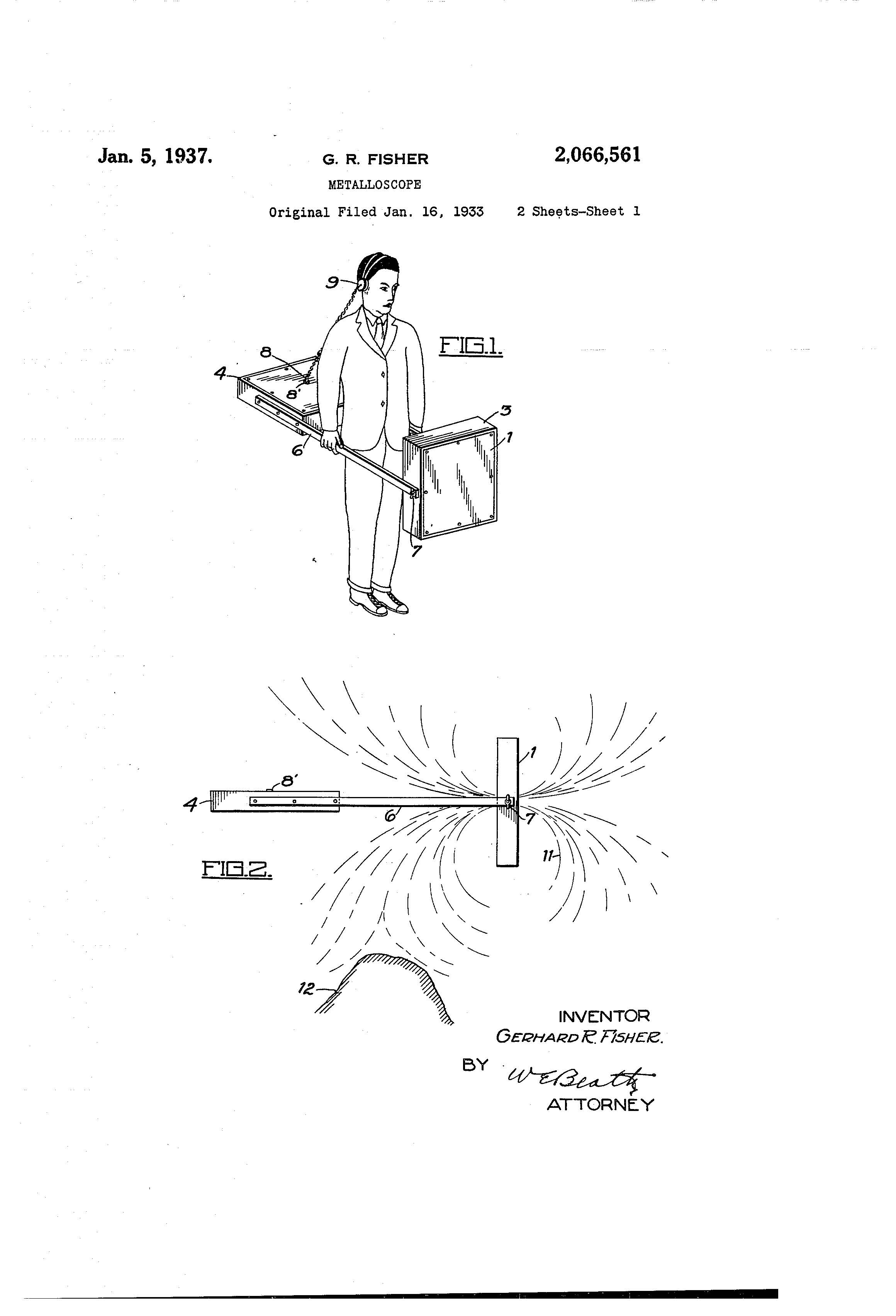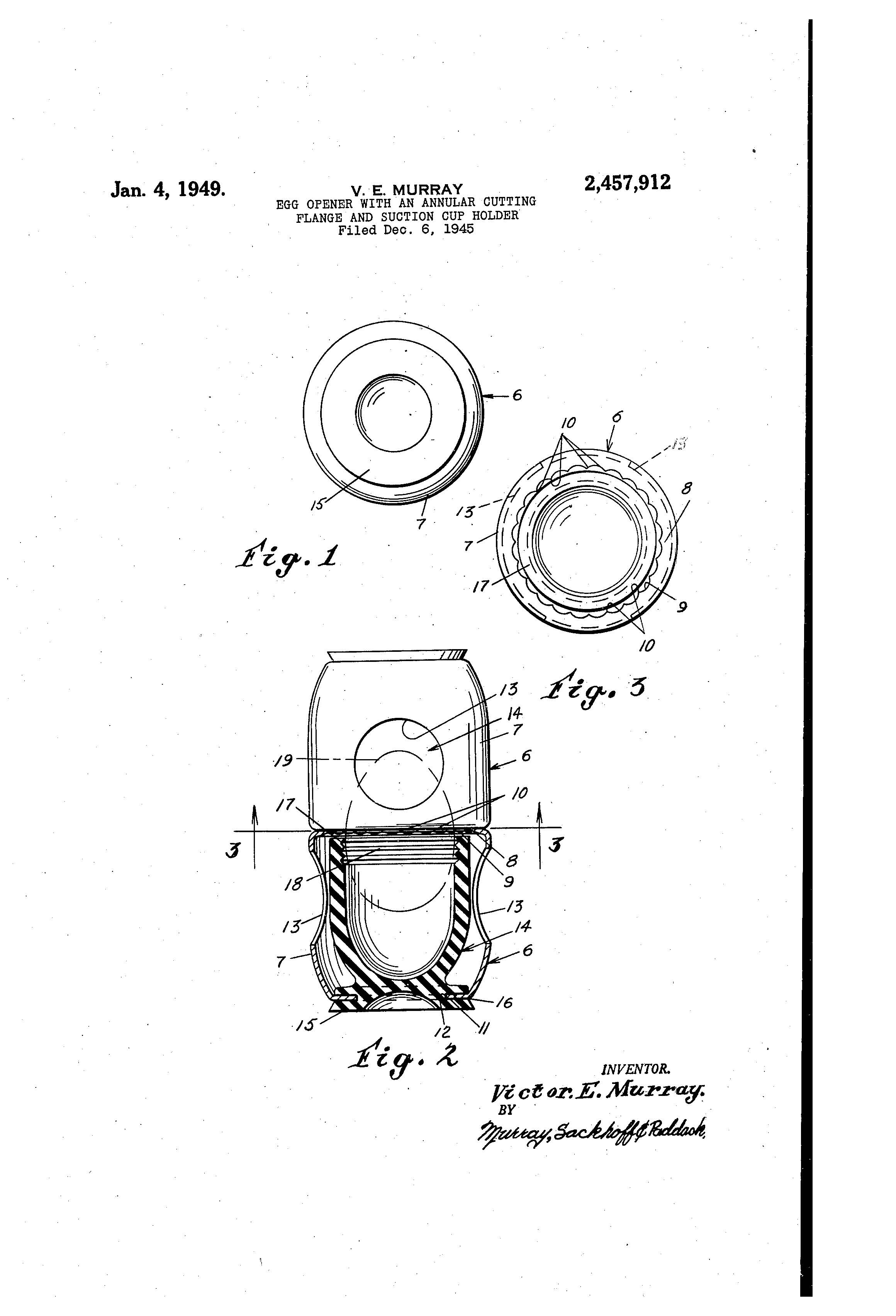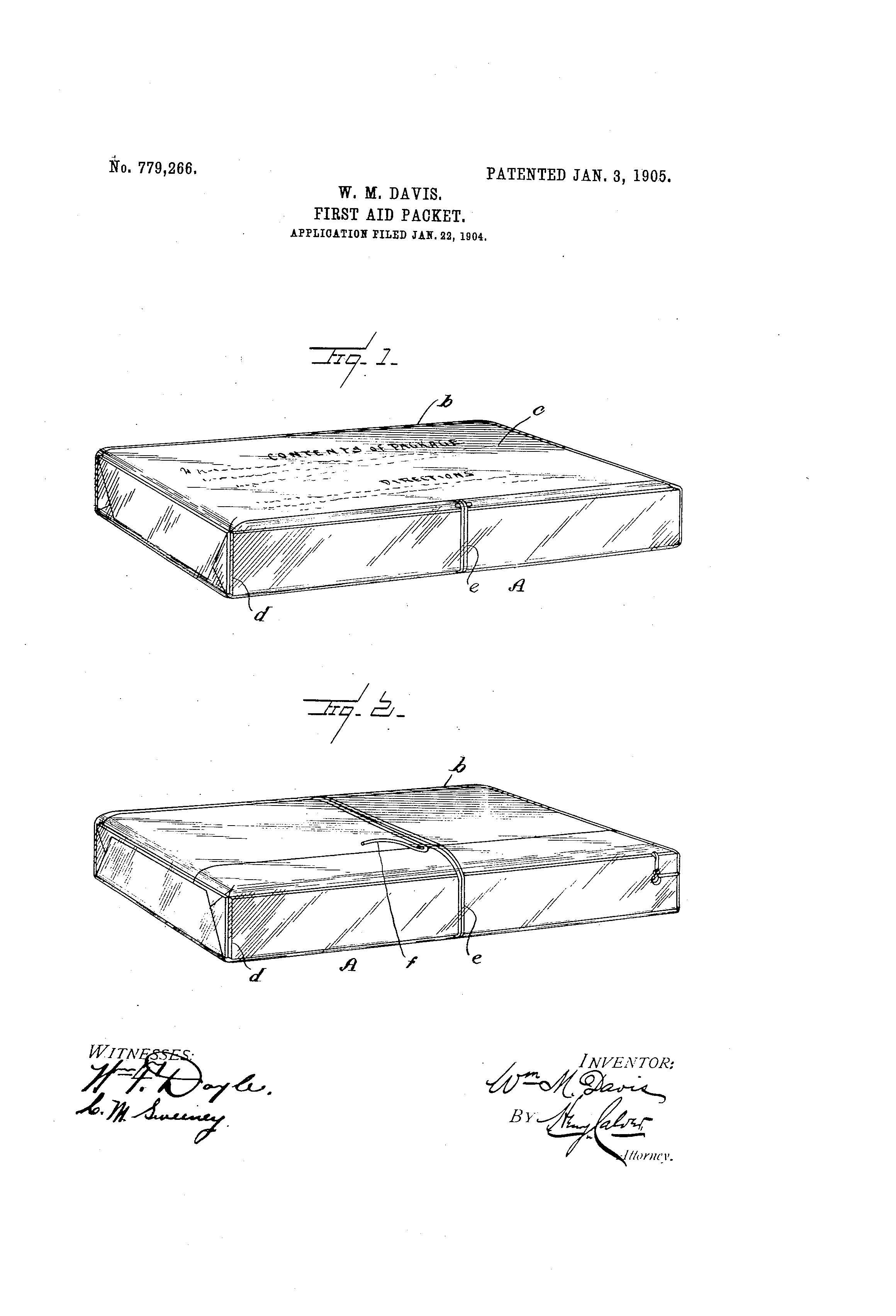The Startup Collaborative Launch Event (Jan. 24)
Suiter Swantz IP will be attending the launch of The Startup Collaborative by Greater Omaha Chamber Tuesday, January 24th, at the Slowdown, from 4-6 PM.
The event will include a celebration of The Startup Collaborative's evolution! Meet the 40+ startups accelerating their business with The Startup Collaborative and the experts helping them do so. Hear pitches from founders in various phases of startup growth. Connect with the broader community dedicated to making this region one that is known for startup success.
The Startup Collaborative is an organization built for founders by founders. It is dedicated to radically improving the odds of startup success, which in turn creates more high-skill jobs and a diversified economy.
To learn more about this event or to register visit The Startup Collaborative's website.
Patent of the Day: Reclining Chair
On this day in 1883 Marcellus Baldwin was granted the patent for RECLINING CHAIR. U.S. Patent No. 270,724.
The object of this invention is to afford a novel and convenient reclining-chair with head and food rest, and so adapted that the declension of the back of the chair may be adjusted from the arm of the chair and will automatically throw the head-rest forward to give increased comfort for the head, and an extension foot-rest which is supported in the same plane with the seat and is returned within and concealed by the chair seat and back when not in use; and it consists, first, in a moveable hinged head-rest attached by suitable devices to the chair-seat, and the means for throwing said head-rest forward by an opposite declension of the chair-back when extended; second, in the arrangement horizontally of the foot support and its flexible extension within the chair seat and back; third, in the arrangement of the slotted plate in the back of a chair to regulate the extension of the foot-rest and its easy adjustment in line with the chair-seat; fourth, in the means for securing the foot-rest from free movement or in a fixed position when extended.



Patent of the Day: Combined Cane and Camp Stool
On this day in 1891 August Schneider was granted the patent for COMBINED CANE AND CAMP STOOL. U.S. Patent No. 444,621.
The invention relates to a combined cane and camp-stool; and its object is to simplify the construction, so as to make the article easy to handle, and, further, to make the parts detachable.


The Ugly Patent Fight, Apple v. Nokia

When cell phones first came on the market, Finnish company Nokia was one of the world’s largest cellphone manufacturers. Nokia branded phones were extremely popular but, as times have changed, the demand for Nokia products has declined significantly.
Nokia has claimed that the cell phone industry would not be what it is today without the help of billions of dollars that they put into research and development. Apple has paid Nokia licensing royalty fees over the past five years based on Fair, Reasonable and Non-Discriminatory (FRAND) terms. An annual report shows Nokia profited more than $1 billion from licensing their patents.
Last month Nokia sued Apple in the U.S. District Court for the Eastern District of Texas as well as courts in Germany for patent infringement. Nokia has since broadened the reach of their litigation to courts in multiple European and Asian countries and filed a lawsuit with the U.S. International Trade Commission (ITC). Nokia alleged that Apple infringed upon 32 technology patents that covered antennas, software, video coding and other functions. Ilkka Rahnasto, Nokia’s head of patent business, said in a statement that “Nokia has created or contributed to many of the fundamental technologies used in today’s mobile devices, including Apple products. After several years of negotiations trying to reach agreement to cover Apple’s use of these patents, we are now taking action to defend our rights.” Although Nokia is no longer one of the world’s largest cellphone manufacturers, many of today’s cellphones and tablets use the patented technology covered in Nokia’s patents.
While some of Nokia’s claims may have merit, others may be more difficult to prove. For example, Nokia recently accused Apple of patent infringement on an electronic device case that includes a hole for a camera lens in the back and room for a battery beneath the display, a patent Nokia received two months prior to the accusation.
Last month Apple filed a lawsuit in the U.S. District Court for the Northern District of California against Acacia Research and Conversant Intellectual Property Management, patent license companies Apple considers to have engaged in anticompetitive behavior with Nokia. Apple argues that some patents were excluded from the royalty agreement between Apple and Nokia and were transferred to these companies to “extract and extort exorbitant revenues unfairly”. In the lawsuit Apple alleged the companies "conspired with Nokia to use unfair and anticompetitive patent assertions to improperly tax the innovations of cell phone makers."
It should be noted that any Nokia patents transferred to Acacia Research and Conversant Intellectual Property Management may not be bound by the FRAND terms. Those companies are considered patent assertion entities and are generally not held to FRAND terms and can demand fees higher than the originally agreed upon amount.
In a statement given to USA TODAY Apple said: "Unfortunately, Nokia has refused to license their patents on a fair basis and is now using the tactics of a patent troll to attempt to extort money from Apple by applying a royalty rate to Apple’s own inventions they had nothing to do with. We are standing up for inventors everywhere by fighting this flagrant anticompetitive practice.” Apple asked the court to award damages and rule that Nokia breached its contract.
Patent of the Day: Apparatus for Cooling and Disinfecting
On this day in 1886 Lewis H. Latimer was granted the patent for APPARATUS FOR COOLING AND DISINFECTING. U.S. Patent No. 334,078.
The object of this invention is to present a large evaporating-surface for the purpose of cooling the air about or passing over it, or to charge the same with chemical agents such as carbolic acid, bromochloralum, etc. - to destroy such odors or germs of disease as may exist therein, and it is accomplished by stretching a webbing of any suitable textile fabric between a reservoir and drip-pan or between two or more reservoirs so arranged as to keep said webbing saturated and supply the waste by evaporation.
This invention can be arranged in many different ways to accommodate the place or use for which the item is to be used; but whether used in a horizontal or vertical position for deodorizing, disinfecting, or cooling, the device only varies in the means adopted for holding it in place, the main features-to wit, the reservoirs and webbing-always remaining the same or only slightly modified in shape.


Patent of the Day: Eye Spray
On this day in 1949 Anna Rehn was granted the patent for EYE SPRAY. U.S. Patent No. 2,458,876.
This invention relates to eye sprays and has for its object the provision of an eye spray for spraying the eyelids with medicated liquids or water to medically treat the lids and surrounding tissue, and/or to massage them to induce increased circulation and stimulate the activities of the associated muscles and tissues.

Patent of the Day: Baseball Mask
On this day in 1888 George Barnard was granted the patent for BASEBALL MASK. U.S. Patent No. 376,278.
The style of mask used by baseball catchers is defective in that no protection is provided against the catcher being hit in the neck by the ball; the object of this invention is to construct an effectual guard and protection by providing an extension of the mask proper to come below the chin of the wearer to protect the chin and neck.

Patent of the Day: Loud Speaker Horn
On this day in 1951 Paul W. Klipsch was granted the patent for LOUD SPEAKER HORN. U.S. Patent No. 2,537,141.
One object of the invention is to provide a horn for; the high frequencies to complement the low frequency horn or' “Woofer” disclosed; in U.S.Patent N0. 2,310,243 issued February 9, 1943, and Patent. No. 2,373,692 issued April. 17, 1945, the required complementary performance being that of transmitting the frequency range from about 400 cycles per second and higher and radiating into an angle about 90° wide and a solid angle of π/2 steradians.
Broadly, an object of the invention is to provide a horn of desired angular radiation in the smallest possible length and space commensurate with the requirements of mouth size, throat size and taper rate, at the same time maintaining such bends as are necessary to minimum angles and to place them at regions in the conduit where the radii of the bends can be kept small and the bend curvature smooth.
A specific object is to provide a horn in which expansion takes place in at single plane for a portion of the horn length to bring the radiation angle up to the desired limits in this plane, then expansion takes place at right angles to said first plane while continuing to expand in the wedge angle reached in the first expansion. Expansion continues until the desired mouth area is accomplished.
Another object is to provide a horn having cooperating side walls and baffles so constructed and arranged that the radiation angle of the horn is determined by the outer surface boundaries or walls of the horn nearest the mouth.
It is also an object to provide a horn of the class described including at least one set of cell baffles which terminate short of the mouth of the horn whereby the individual cell mouths are small compared to the shorter wave lengths to be radiated.

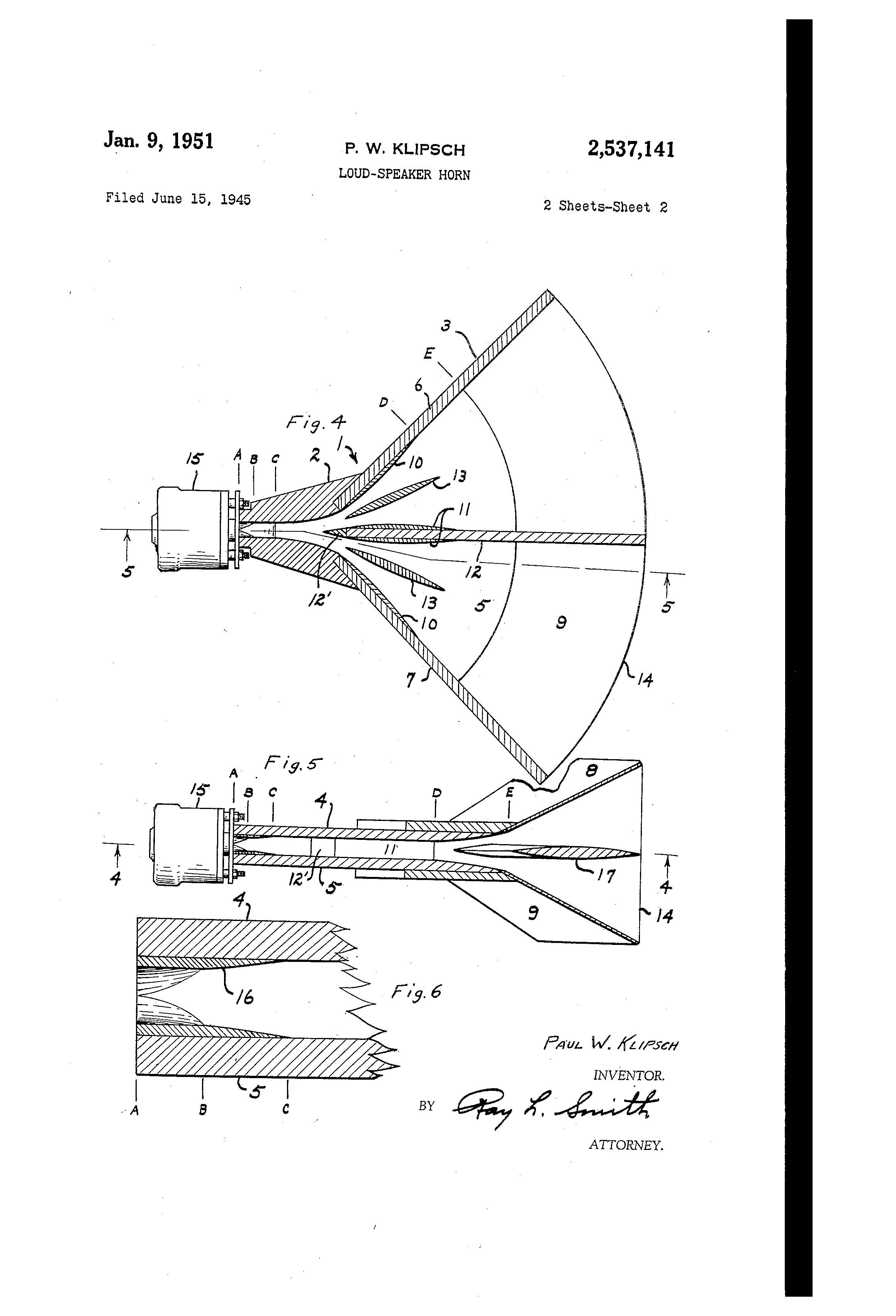
Patent of the Day: Vermin Trap or Insulator
On this day in 1880 Earl P. Denton was granted the patent for VERMIN TRAP OR INSULATOR. U.S. Patent No. 223,321.
This invention is designed to protect the legs of furniture from insects and vermin.
The invention consists of a cup or receptacle having a central compartment, whose vertical sides extend upwardly from the bottom of the cup and have a flange or brim extending outwardly from their summit. The sides of the cup extend to a less height than those of the central compartment, and the sides of said compartment form, with the bottom, a trough or meat for holding suitable liquid for destroying the insect falling therein.

Patent of the Day: Metalloscope
On this day in 1937 Gerhard R. Fisher was granted the patent for METALLOSCOPE. U.S. Patent No. 2,066,561.
This patent relates to metalloscopes, a method and means for indicating the presence of metals that are buried such as ore, pipes, or the like.
An object of the present invention is to provide a simple apparatus which is preferably unitary and which is entirely portable, for instantaneously indicating the presence of metal, such as buried ore, pipes, or the like.
This is accomplished by generating electrical waves in balanced relation to a receiver, whereby the balanced relation is upset when the apparatus is brought into the vicinity of a metallic body, this unbalanced condition arising from the fact that the field is generated in such a way that the metallic body affects one portion of the field more than it does the other.


Patent of the Day: Egg Opener with Annular Cutting Flange and Suction Cup Holder
On this day in 1949 Victor E. Murray was granted the patent for EGG OPENER WITH AN ANNULAR CUTTING FLANGE AND SUCTION CUP HOLDER. U.S. Patent No. 2,457,912.
This invention relates to egg openers and has for an object the provision of a simple and inexpensively constructed implement whereby an egg may be quickly served on a similar diameter thereof, and its contents emptied whereupon the shell maybe ejected from the implement.
Another object of the invention is to provide a device of the class referred to which may be manipulated in a cleanly fashion soiling the fingers and without danger of dropping pieces of the egg shell into the contents thereof during operation.
Still another object of the invention is to provide means to handle and open a hot egg without burning ones fingers.

Patent of the Day: First Aid Packet
On this day in 1905 William M. Davis was granted the patent for FIRST AID PACKET. U.S. Patent No. 779,266.
This invention relates to what are known as “first-aid” or “emergency” packets carried by soldiers or others exposed to danger and containing antiseptic compresses, band ages, and other appliances for use in the first dressing of wounds.
The first-aid packets heretofore generally in use have been provided with wrappers of cloth coated with rubber or wrappers of Mackintosh cloth, which is more or less waterproof, and on the outside of which wrappers was printed a list of the contents of the packets, with directions for use. These old-style first aid packets have not always given entire satisfaction, in that they have not been sufficiently tight, and consequently not as waterproof and germ-proof as they should be, and this has been particularly the case with packets used in hot and moist climates, where the climatic influences have a deteriorating or rotting effect on the rubber of the wrappers, so that the contents of the packets became after a time more or less exposed to contamination and infection by disease germs.
The objections above referred to are obviated by the present invention, which provides a first-aid packet with a wrapper which is absolutely waterproof or moisture-proof, which is not subject to deterioration by atmospheric influences in warm and moist climates, which is sufficiently strong and tough to resist the wear to which it may be subjected, and which can be quickly and conveniently opened when an emergency occurs which requires the use of the contents of the packet.
To this end the wrapper of the improved packet consists of a sheet of tough and flexible substance which is entirely water-resisting and which is preferably of celluloid or some similar cellulose compound and in which the packet is enveloped by-a proper folding of the wrapper, and when this has been done the joints of the wrapper are hermetically sealed by a waterproof or water-resisting adhesive, which will preferably be a solution of celluloid or cellulose substance and which when dried will not lose its adherent qualities by any amount of exposure to atmospheric heat or moisture. The packet is preferably provided beneath the waterproof wrapper with an encircling cord or small flexible wire, the end of which protrudes slightly through an opening made therefor in the wrapper and which opening is afterward hermetically sealed, and when it is desired to open the packet the protruding end of the cord or wire will be seized,and by pulling thereon the-wrapper will be cut, so that it can be quickly and easily undone. Also to hold the packet in shape its edges are preferably encircled beneath the waterproof wrapper by a band of somewhat stiff and preferably waterproof material, which may be celluloid or vulcanized fiber about the thickness of somewhat thin cardboard.



